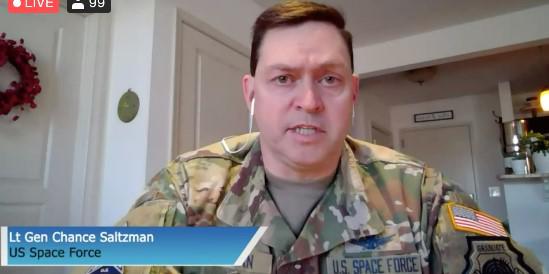Guardians Need Advanced Virtual Training for Space Operations
As the year-old U.S. Space Force increasingly supports the U.S. combatant commands with space-based capabilities and associated warfighters, the service needs to ramp up its training.
The service’s guardians increasingly face a contested environment in space and must advance their ability and science of conducting space operations, said Lt. Gen. Chance Saltzman, USSF, deputy chief of Space Operations.
“Being in a contested domain radically changes the skills, the experience and the training that our operators are going to have to bring to the fight,” the general said, speaking at an Aerospace Corp. event yesterday.
Serving as Space Force’s first deputy chief operations officer, Gen. Saltzman has responsibility across space operations, intelligence, sustainment, cyber and nuclear operations.
“Our adversaries saw the tremendous strategic advantages we got from space capabilities and so they started investing heavily in capabilities to deny us those advantages,” Gen. Saltzman said. “And that changes everything. Because once you have to compete in a contested domain, your training shifts, the type of equipment you buy shifts, your tactics, your concept of operations, the procedures you use, how you go about your daily your business, that is different. [It] is a different process when you think an adversary is trying to deny something.”
The young service’s current situation does present opportunity for improvement when considering what the challenges may be in the future, how to build the necessary capabilities for that environment and how to provide the appropriate training tools for operators. “We are in an extremely technical field,” the general noted. “We don't see our assets. We remotely pilot all of our capabilities. We have to advance the capabilities that we give our operators so that they're going to be ready for a fight that could extend well into space and is likely to extend into cyberspace.”
Any Guardian conducting space operations has to have an adroit understanding of astrodynamics, he continued. “If you don't understand the rocket science behind it, it's really hard to visualize. It is not something that just comes intuitively. If you say, ‘Well I wonder how these satellites are interacting,’ or ‘I wonder how the RF spectrum is interacting with our antennas,’ or ‘I wonder how the atmosphere is affecting my signals,’ those things aren't intuitive . You have to have this technical depth in order to understand the operations, as well as understand how an adversary might overcome those capabilities and interfere, degrade or even destroy your capabilities.”
One solution is to provide an advanced live, virtual and constructive environment in which operators can train. “Clearly, we need to leverage technology to give our operators virtual and constructive ranges and training space, so that they can make mistakes and learn outside of the actual space domain,” Gen. Saltzman stated. “I don't think that's a big stretch technologically to have virtual ranges, to have test ranges, to have those kinds of capabilities virtually and constructive, and I think we need to invest heavily in those.”
Understandably, the general sees differences between officers like himself who grew up under Air Force Space Command and did not necessarily have to protect the space domain, and younger officers who are learning right from a contested environment.
“You ought to hear these young officers and enlisted people talk about their jobs,” he said. “If you go to a Space Flag [exercise] and listen to some of the debriefs, it would blow your mind the way that they are seeing their battlespace. The way that they are visualizing the tactics and the procedures that they need. They have a conceptual understanding of this in a way that I struggle with sometimes. Part of this is just generational. They are growing up in a far different space environment than I did, when it was just closing a link so that the RTS [remote tracking stations] could connect for a normal telemetry. But when you're talking about an adversary in close proximity that could counter your system kinetically with robotic arms or with kinetic projectiles, they are starting to have different conversations.”
As such, Guardians need the appropriate space-related tools, simulators and virtual ranges “to really explore and test and make mistakes in that virtual space,” the general emphasized.
Gen. Saltzman also noted that the service can leverage almost immediate training in between operations.
“We can take advantage of the fact that we largely do our operations from our homeland,” he stated. “We don't have to deploy overseas too much; we mostly employ in place. Today, I'm doing combat operations for U.S. Space Command and tomorrow I'm doing advanced training. That is what I'll call a training refresh cycle. It can be really fast because we don't have to deploy downrange where somebody might be losing some of the high-end capabilities and skills while they're doing their day-to-day missions. Instead, we're right there together, and you're doing advanced training and you're doing new tactics, new procedures and then you go in and do the real-world operations and then the next day you're training again.
“It's going to be a little bit before we put all the right structures in place but that's the idea,” Gen. Saltzman said.





Comments